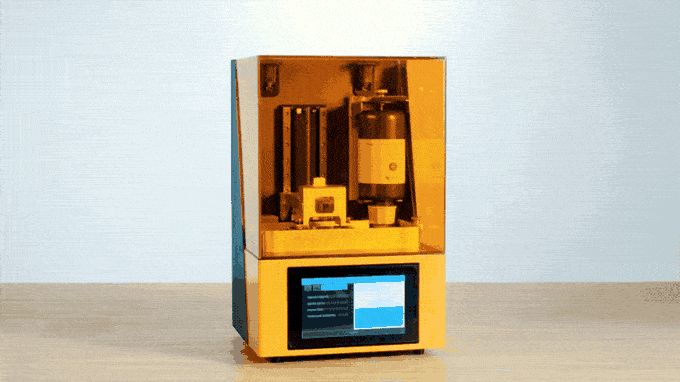![The new Dazz 3D L120 SLA 3D printer [Source: Dazz 3D]](https://fabbaloo.com/wp-content/uploads/2020/05/image-asset_img_5eb0a7c7bbad1.jpg)
I’m looking at a new SLA 3D printer that just appeared on Kickstarter, the Dazz 3D L120.
This is a resin-based 3D printer, like many others currently available. In fact, there are so many options for this type of machine it is quite difficult to stand out and attract customers.
What has the China-based company included on this device to make it attractive? Let’s find out.
Unlike some systems that use a laser to selectively solidify layers, the Dazz 3D L120 uses an LCD system. In this approach, the LCD panel sits at the bottom of the machine, with the clear-bottomed resin tank laying on top. When a layer is to be fused, the LCD panel lights up all appropriate pixels. After a moment, the layer is complete and the machine slides up to allow a subsequent layer to be produced.
This style of 3D printing can be faster than lasers, as the entire layer is produced simultaneously. It’s an approach used by a few other SLA 3D printer manufacturers, so it isn’t unique.
Another approach for speeding prints is the method of peeling the fresh layer off the bottom of the tank, to which it is slightly adhered after fusing. A slow, tilted peel is what most machines do, and that seems to be what Dazz 3D is doing here. This machine does not include any fancy peeling speedup techniques as do Carbon or Uniz. Thus their print speed of “up to” 36mm per minute is not particularly rapid.
Their build volume of 120 x 66 x 150 mm is not particularly larger, and is in fact quite a bit smaller than most of its competitors. However, the fine details one can produce on this device suggest that most of the prints will be small in any case.
What is interesting about this machine is that the LCD panel being used is of higher resolution. Their 2K LCD panel holds more pixels (2560 x 1440) than typical panels used in other 3D printers, and can actually produce higher XY resolution prints than some laser systems.
![Example of resolution advantages on the Dazz 3D L120 3D printer [Source: Dazz 3D]](https://fabbaloo.com/wp-content/uploads/2020/05/image-asset_img_5eb0a7c84d3fa.jpg)
Laser systems must balance speed of movement with laser strength to achieve an optimum solidification. The LCD approach means the machine need only determine the appropriate timing for the solidification of the photopolymer, making it easier to tune the print process.
The result here is that the Dazz 3D L120 offers higher resolution than almost all of its competitors, at 0.047mm, vs up to 0.150 for the Form 2, for example.
Another very useful feature on this machine that really should be mandatory on all resin machines is an air purification system. Many resins are toxic and at the least very smelly, so an air filtration system is quite welcome.
I quite like the auto-fill resin system. Basically you drop in the resin and it is automatically metered into the resin tank, and this mostly eliminates the need to supervise the print and add resin periodically, except on very large prints.
![Print quality appears excellent on the Dazz 3D L120 3D printer [Source: Dazz 3D]](https://fabbaloo.com/wp-content/uploads/2020/05/image-asset_img_5eb0a7c89bffe.jpg)
While not unique, the Dazz 3D L120 includes dual rails for its Z-axis, something that more resin 3D printers should include. This increases the stability of the print platform as it is gradually raised during 3D printing. As you might imagine, this is even more critical when there are higher resolutions at play with this machine.
![The initial set of inexpensive 3D printer resins [Source: Dazz 3D]](https://fabbaloo.com/wp-content/uploads/2020/05/image-asset_img_5eb0a7c8ea6f5.jpg)
Another very intriguing aspect of this machine is its family of resins. Like many companies, they are simultaneously releasing a set of competent resins with various functions, such as rigid, castable, high temperature, food safe, etc. But what’s different about them is the price. Their pricing is quite low compared to some other manufacturers, which charge sometimes over US$200 per liter.
Here was have a half liter going for only US$19.
But hold on, that’s the introductory price, and it’s only half a liter. The full regular price for a liter will be around US$64. That’s still a very decent price. Their most expensive resin, the castable material, will be US$138 per liter.
I’m wondering if this pricing will cause a jitter in the market, which could use one because the price of resin is typically far higher than it should be.
![Dazz 3D L120's two models: Basic on the left, and Pro on the right [Source: Dazz 3D]](https://fabbaloo.com/wp-content/uploads/2020/05/image-asset_img_5eb0a7c9718d0.jpg)
As for the pricing of the machine, Dazz 3D is offering them an excellent price level. There are two models, the Basic and Pro versions of the L120. They are identical, except that the Basic version does not include a seven-inch touchscreen, automated resin fill, air purifier and fancy resin wiper. To me, the Basic version is much like similar competing machines, except for the 2K LCD panel. The Pro version is the machine with most of the differentiating features.
Pricing is US$1099 and US$1399, respectively, for the two models, with some discounts available for early buyers on Kickstarter. These prices are very good for resin 3D printers, far below some of their competitors.
But this is a Kickstarter, and one must consider the risks of buying. While you can review our checklist, this company has already produced several other 3D printers, so it would appear they have good knowledge of how to proceed, unlike some other projects.
Via Kickstarter and Dazz 3D











FELIXprinters has released a new bioprinter, the FELIX BIOprinter, which is quite a change for the long-time 3D printer manufacturer.